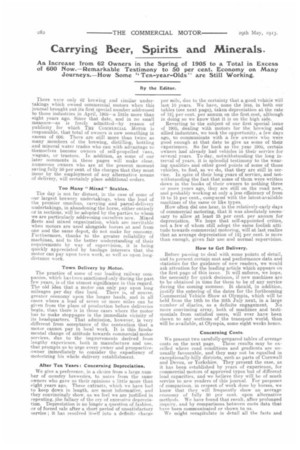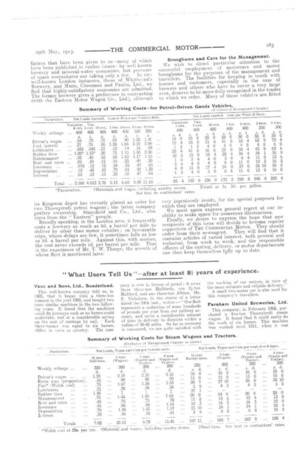Carrying Beer, Spirits and Minerals.
Page 14

Page 15

If you've noticed an error in this article please click here to report it so we can fix it.
An Increase from 62 Owners in the Spring of 1905 to a Total in Excess of 600 Now.—Remarkable Testimony to 50 per cent. Economy on Many Journey s.—How Some " Ten-year-Olds " are Still Working.
By the Editor.
There were only 62 brewing and similar undertakings which owned commercial motors when this journal brought out its first special number addressed to those industries in April, 1905—a little more than eight years ago. Since that date, and in no small measure—as is freely admitted—by reason of publicity for which THE C OMAIERCIAL MOTOR is responsible, that total of owners is now something in excess of 600. There are still more than twice as many members of the brewing, distilling, bottling and mineral water trades who can with advantage to themselves become owners of self-propelled vans, wagons, or tractors. In addition, as some of our later comments in these pages will make clear, numerous owners who are at the present moment saving fully 50 per cent. of the charges that they must incur by the employment of any alternative means of delivery, will certainly place additional orders.
Too Many "Mixed" Stables.
The day is not far distant, in the case of some of our largest brewery undertakings, when the lead of I he premier omnibus, carrying and parcel-delivery undertakings, in abandoning the horse, either entirely or in sections, will be adopted by the parties to whom we are particularly addressing ourselves now. Mixed Beets and mixed organization, which are inevitable when motors are used alongside horses at and from one and the same depot, do not make for economy. Furthermore, thanks to the greater reliability of machines, and to the better understanding of their requirements by way of supervision, it is being quickly appreciated by haulage interests that the motor can pay upon town work, as well as upon longdistance work.
Town Delivery by Motor.
The practice of some of our leading railway companies, which has iseen sanctioned only during the past few years, is of the utmost significance in this regard. The old idea that a motor can only pay upon long mileages per day dies hard. There is, of course, greater economy upon the longer hauls, and in all eases where a lead of seven or more miles can be given from the place of production before deliveries begin, than there is in those cases where the motor has to make stoppages in the immediate vicinity of its headquarters. That admission, however, is very .different from acceptance of the contention that a motor cannot pay in local work. It is this fundamental change of attitude towards commercial-motor services, due to the improvements derived from lengthy experience, both in manufacture and use, that. prompts us to urge every owner and prospectiveowner immediately to consider the expediency of motorizing his whole delivery establishment.
After Ten Years: Concerning Depreciation.
We give a preference, in a choice from a large number of country breweries, to notes from the same owners who gave us their opinions e little more than eight years ago. These extracts, which we have had to keep down in length, are most informative, and they convincingly show. as we feel we are justified in repeating„ the fallacy of the cry of excessive depreciation. Depreciation is no longer a question of fashion. or of forced sale after a short period of unsatisfactory service ; it has resolved itself into a definite charge per mile, due to the certainty that a good vehicle will last 10 years. We have, none the less, in both our tables (see next page), taken. depreciation at the rate of 121 per cent. per annum on the first cost, although in doing so we know that it is on the high side.
Reverting to the subject of our first special issue of 1905, dealing with motors for the brewing and allied industries, we took the opportunity, a few days ago, to communicate with a few owners who were good enough at that date to give us some of their experiences. So far back as the year 1905, certain owners had already had vehicles in their service for several years. To-day, notwithstanding the long interval of years, it is splendid testimony to the wearing qualities a.nct other good points of some of those vehicles, to find, as we do, that they are still in service. In spite of their long years of service, and notwithstanding the fact that some of them were written down in the books of their owners to nothing three or more years ago, they are still on the road now, and probably working at only a less efficiency of from 10 to 15 per cent., compared with the latest-available machines of the same or like types.
How often did one hear, in the relatively-early days of commercial motoring, that it was absolutely necessary to allow at least 25 per cent. per annum for depreciation. We hope that sell-appointed critics, not a few of whom still adopt the same foolish attitude towards commercial motoring, will at last realize that an average depreciation of 14 per cent. is more than enough, given fair use and normal supervision.
How ta Get Delivery.
Before passing to deal with some points of detail, and to present certain cost and performance data and statistics for the guidance of new readers, we would ask attention for the leading article which appears on the first page of this issue. It, will enforce, we hope, the necessity for quick decision, if new machines are to be obtained in time for them to be of any service during the coming summer. It should, in addition, justify the entering of the dates for the forthcoming Commercial Vehicle Show at Olympia, which will be held from the 18th to the 26th July next, in a large number of diaries, as a definite engagement. No more convincing array, both of machines and testimonials from satisfied users, will ever have been shown to any sections of the transport world, than will be available, at Olympia, some eight weeks hence.
Concerning Costs.
We present two carefully-prepared tables of average costs on the next page. These results may be excelled where road conditions and gradients are unusually favourable, and they may not be equalled in exceptionally-hilly districts, such as parts of Cornwall and Devon, or Yorkshire. They present the case, as it has been established by years of experience, for commercial motors of approved types but of different load capacities, and we believe they will be of much service to new readers of this journal. For purposes of comparison, in respect of work done by horses, we know that they will frequently show an average economy of fully 50 per cent. upon alternative methods. We have found that result, after prolonged inquiry, and by comparisons between costs data that have been communicated or shown to us.
We might recapitulate in detail all the facts and figures that have been given to us.-mauy of which haVe been published in earlier issues--by well-known brewery and mineral-water companies, but pressure of space necessitates our taking only a few.In two well-known London instances, those of Whit breads Brewery, and Mann, Grossman and Paulin, Ltd., we find that highly-satisfactory economies are admitted. The former brewery gives a preference to contracting (with the Eastern Motor Wagon Go., Ltd.), although its Kingston depot has recently placed an order for two Thornycroft, petrol wagons ; the latter company prefers ers o w n ers h ip Stansfield and Co., Ltd., also -hires from the " Eastern" people. Broadly speaking, in the London area. it frequently costs a beewery as much as 3d. a barrel per mile to deliver by other than motor vehicles ; on favourable trips, where delays are few, it sometimes falls as low as 2d. a barrel per mile. Against this, with motors, the cost never exceeds Id. per barrel per mile. That. is the experience of Mr. T. W. Thorpe, the growth of whose fleet is mentioned later. Broughams and Cara for the Management. 'We wish to direct particular attention to the successful employment of motorcars and motor broughams for the purposes of the management and travellers. The facilities for keeping in touch with houses and customers, especially in the case of brewers and others who have to cover a very large area, deserve to be more-fully recognized in the trades to which we refer. Many of these vehicles are fitted very ingeniously inside, for the special purposes for which they are employed. We must again express general regret at our inability to make space for numerous illustrations. Finally, we desire to express the hope that new recipients of this issue will decide to become regular supporters of Tin COMMERCIAL MoToa. They should order from their newsagent. They will find that it contains articles of varied interest, both general and technical, from week to week, and the responsible officers of the carting, delivery, or motor depa,rtments can thus keep themselves fglly up to date.






























